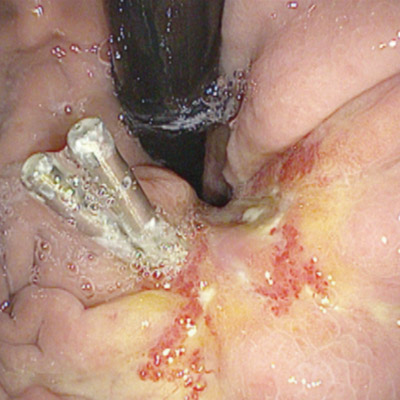Case Report: Unchanged Radiation-induced Ulcer after Selective Internal Radiation Therapy (SIRT)
Dörte Wichmann and Ulrike Schempf
Interdisciplinary Endoscopy, University Hospital Tübingen
SIRT is a radiotherapeutic, interventional treatment option for unresectable primary liver tumors and metastases. During SIRT, microspheres labelled with thebeta-emitter yttrium-90 (90Y-microspheres) are intra-arterially infused into tumor tissue. The local radiation effect ranges about 11 mm around the microspheres. This is a targeted tumor treatment because hepatic tumors are mostly supplied by arterial blood, whereas normal liver tissue mainly receives its nutrients from the portal vein. The post-interventional transport of microspheres from the liver to neighboring organs may cause severe complications. As a standard procedure, a liver MRI as well as an angiography of the upper abdomen are performed in order to rule out any shunts and allow the angiographic embolization of these vessels, if required
We present a case of a 46-year-old patient with an HCV-associated, multilocular hepatocellular carcinoma. Therapy with Sorafenib was discontinued as a result of serious side effects. SIRT was recommended by a multidisciplinary tumor board. Microspheres were administered twice, in February and April 2016, after appropriate preliminary examinations were conducted for each case respectively.
In October 2016, the patient developed an upper G.I. bleeding. During gastroscopy a 2 x 2 cm fibrin-covered ulcer was found in the cardia, along the minor curvature. A biopsy of the ulcer was taken, and multiple microspheres were found in the histology specimen. In the course of treatment, endoscopic interventions were necessary because of recurrent ulcer bleeding. Due to progression of esophageal varices, the patient needed to be closely monitored, which allowed us to present a detailed 12-month documentation of the radiation-induced ulcer.
Figures





References:
- Crowder CD, Grabowski C, Inampudi S, Sielaff T, Sherman CA, Batts KP. ‘Selective Internal Radiation Therapy-induced – Extrahepatic Injury an Emerging Cause of Iatrogenic Organ Damage’. American Journal of Surgical Pathology 2009; 33: 963–975.
- Sangro B, Martinez-Urbistondo D, Bester L, Bilbao JI, Coldwell DM, Flamen P, Kennedy A, Ricke J, Sharma RA. ‘Prevention and Treatment of Complications of Selective Internal Radiation Therapy: Expert Guidance and Systematic Review’. Hepathology 2017; 66: 969–982.
- Abdel-Rahman OM, Elsayed Z. ‘Yttrium-90 microsphere radioembolisation for unresectable hepatocellular carcinoma’. Cochrane Database Syst Rev. 2016 Feb 16; 2: CD011313 doi: 10.1002/14651858.CD011313.pub2.


